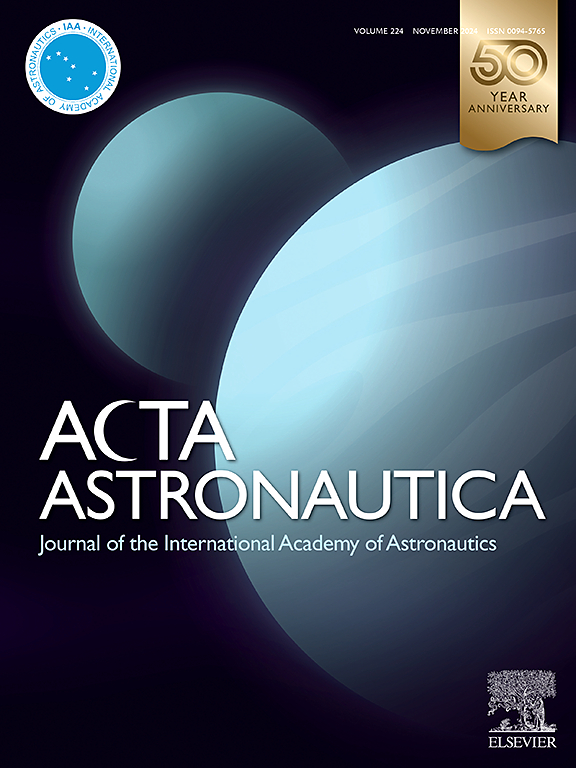A novel tether-net configuration with double-linked bullets for suppressing reshrinking motion after full deployment
IF 3.1
2区 物理与天体物理
Q1 ENGINEERING, AEROSPACE
引用次数: 0
Abstract
Tether-nets have attracted considerable attention as tools for capturing space debris. However, owing to the lack of aerodynamic drag to resist collapse in space, tether-nets tend to shrink back after deployment because of tension in the tether. Various strategies have been proposed to suppress this reshrinking motion before debris capture, such as equipping bullets with thruster modules to control their trajectory after ejection and incorporating a bullet ejection-angle adjustment mechanism. However, these approaches complicate the tether-net design and/or ejection systems. In this study, a novel tether-net configuration comprising double-linked bullets, wherein the inner and outer bullets are connected via a tether, was proposed to prevent the tether-net from reshrinking after full deployment. Upon full deployment, as the bullets start to rebound due to impulsive tension, the outer bullets fly outward, pulling the inner bullets and exchanging momentum to suppress their rebounding motion. The effectiveness of the double-linked bullets in suppressing the reshrinking motion of the tether-net was demonstrated by comparing the results with those obtained using typical single-linked bullets. Furthermore, the influence of the inner and outer bullet mass ratio on the tether-net deployment and reshrinking motion was numerically analyzed to identify the optimal mass ratio for effectively suppressing the reshrinking motion. The results indicate that a mass ratio of 1.0, or slightly less, between the outer and inner bullets is most effective in suppressing tether-net reshrinking.
新型系绳网配置与双链子弹,用于抑制完全展开后的回缩运动
作为捕获空间碎片的工具,系绳网引起了相当大的关注。然而,由于缺乏空气动力阻力来抵抗空间坍塌,系留网在部署后往往会因系留的张力而回缩。为了在捕获碎片之前抑制这种回缩运动,人们提出了各种策略,例如在子弹上安装推进器模块,以控制子弹弹射后的轨迹,以及安装子弹弹射角度调整机制。然而,这些方法都使系留网设计和/或弹射系统复杂化。在这项研究中,提出了一种新型系留网配置,该配置由双连式子弹组成,其中内子弹和外子弹通过系留连接,以防止系留网在完全展开后重新收缩。完全展开后,当子弹因脉冲拉力开始反弹时,外层子弹向外飞出,拉动内层子弹并交换动量以抑制其反弹运动。通过与使用典型单链子弹的结果进行比较,证明了双链子弹在抑制系绳网回缩运动方面的有效性。此外,还对内外弹质量比对系绳网展开和回缩运动的影响进行了数值分析,以确定有效抑制回缩运动的最佳质量比。结果表明,内外弹质量比为 1.0 或略低于 1.0 时,能最有效地抑制系绳网的再收缩。
本文章由计算机程序翻译,如有差异,请以英文原文为准。
求助全文
约1分钟内获得全文
求助全文
来源期刊

Acta Astronautica
工程技术-工程:宇航
CiteScore
7.20
自引率
22.90%
发文量
599
审稿时长
53 days
期刊介绍:
Acta Astronautica is sponsored by the International Academy of Astronautics. Content is based on original contributions in all fields of basic, engineering, life and social space sciences and of space technology related to:
The peaceful scientific exploration of space,
Its exploitation for human welfare and progress,
Conception, design, development and operation of space-borne and Earth-based systems,
In addition to regular issues, the journal publishes selected proceedings of the annual International Astronautical Congress (IAC), transactions of the IAA and special issues on topics of current interest, such as microgravity, space station technology, geostationary orbits, and space economics. Other subject areas include satellite technology, space transportation and communications, space energy, power and propulsion, astrodynamics, extraterrestrial intelligence and Earth observations.
 求助内容:
求助内容: 应助结果提醒方式:
应助结果提醒方式:


